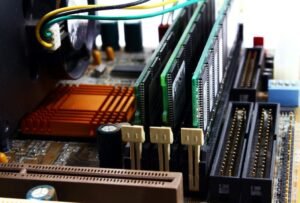AI Applications to See the World and Make Sense of It
Artificial Intelligence (AI) has revolutionized various industries, and one of its most fascinating applications is the ability to see the world and make sense of it. Through advanced computer vision and image recognition technologies, machines can now understand and interpret visual data, mimicking the human ability to perceive and comprehend the world around us.
Key Takeaways
- AI enables machines to see and understand visual data like humans.
- Computer vision and image recognition technologies are at the forefront of AI’s visual perception capabilities.
- From healthcare to self-driving cars, AI’s visual intelligence has wide-ranging applications.
Understanding the Basics of AI Vision
At the core of AI vision lies computer vision, which focuses on giving machines the ability to “see” and analyze visual data. *Computer vision algorithms extract meaningful information from images and videos by analyzing patterns, shapes, colors, and textures, providing machines with a visual understanding of their surroundings.*
Image recognition, on the other hand, involves training AI models to identify or categorize specific objects or features within images or videos. By labeling and annotating vast amounts of data, AI models learn to recognize and differentiate between various objects and concepts, enabling them to classify and understand visual content more accurately.
By combining these techniques, AI systems can go beyond simple image recognition and delve into understanding complex scenes, context, and even emotions portrayed in images.
Applications of AI Vision
The applications of AI vision are vast and diverse, ranging from enhancing healthcare diagnostics to enabling autonomous vehicles to perceive their surroundings. Here are some notable examples:
- *Healthcare*: AI vision is transforming medical imaging through more accurate diagnosis and image interpretation, aiding in early disease detection and treatment planning.
- *Retail*: Visual search capabilities allow consumers to find products by simply taking a photo, enhancing the shopping experience while helping businesses improve their product recommendations and inventory management.
- *Manufacturing*: Smart factories utilize AI vision for quality control, detecting defects in products during the production process, and optimizing workflow efficiency.
Impacts and Future Developments
The integration of AI vision into various industries has already shown significant impacts, improving efficiency, accuracy, and decision-making processes. With continued advancements in computer vision algorithms and access to more extensive data sets, the future possibilities are boundless. *As AI vision evolves, it has the potential to revolutionize sectors such as augmented reality, robotics, and even everyday life, paving the way for a more seamlessly interconnected world.*
| Industry | Application |
|---|---|
| Healthcare | Medical imaging and diagnosis |
| Retail | Visual product search and recommendation |
| Manufacturing | Quality control and defect detection |
| Efficiency | Accuracy | Decision-making |
|---|---|---|
| Automates tasks | Reduces human error | Improves real-time analysis |
| Enhances workflow | Enables precise measurements | Aids in data-driven decisions |
| Augmented Reality | Robotics | Everyday Life |
|---|---|---|
| Integration with AR applications | Autonomous robots with advanced perception | Smart homes and personal assistants |
| Enhanced real-time information overlay | Improved object recognition and manipulation | Automation of everyday tasks |
The Power of AI Vision
Artificial Intelligence has unlocked the power of *visual perception, enabling machines to see and interpret the world like humans do*. By leveraging computer vision and image recognition technologies, AI has found applications in numerous industries, transforming processes and decision-making. As we continue to innovate, the potential for AI vision to shape our future is immense.

Common Misconceptions
Misconception 1: AI can fully understand and interpret visual information like humans
One common misconception about AI is that it can completely understand and interpret visual information in the same way humans do. While AI algorithms have made significant progress in computer vision tasks, they still lack the context and reasoning capabilities of the human brain.
- AI systems can recognize patterns and objects accurately, but they struggle with complex contexts.
- AI can misinterpret visual cues and make mistakes that humans would easily recognize.
- AI’s interpretations are based solely on data it has been trained on, limiting its ability to make sense of unfamiliar visual scenarios.
Misconception 2: AI can replace human creativity and intuition in visual analysis
Another misconception is that AI can replace human creativity and intuition in visual analysis. While AI can perform certain tasks with high precision and efficiency, it cannot replicate the human ability to think critically, make connections, and analyze visual information holistically.
- AI lacks the ability to have original thoughts, ideas, and insights that humans can generate based on their experience and knowledge.
- AI systems are limited to working with existing data and patterns, whereas humans can transcend these patterns and create new meaning.
- AI is more effective as a tool to augment human capabilities rather than replace them entirely in visual analysis.
Misconception 3: AI in visual applications is infallible and unbiased
Many people mistakenly believe that AI in visual applications is infallible and unbiased. However, AI systems are built by humans and are prone to inherit biases from the data they are trained on, as well as the algorithms used to develop them.
- AI can perpetuate societal biases and prejudices present in training data, leading to unfair or discriminatory outcomes.
- AI may exhibit unexpected behaviors or biases due to variations in real-world scenarios that were not fully accounted for during training.
- AI is not inherently objective or ethical and requires careful monitoring and oversight to ensure fairness and accountability.
Misconception 4: AI can autonomously analyze and interpret visual data without human involvement
There is a misconception that AI can autonomously analyze and interpret visual data without human involvement. While AI can automate certain visual analysis tasks, human supervision and validation are still crucial to ensure accuracy and avoid misinterpretations.
- AI systems require human guidance and feedback to improve their accuracy and performance over time.
- Human experts are needed to validate and provide insights on the output generated by AI systems.
- Human involvement is necessary to contextualize and understand the implications of AI-generated visual insights.
Misconception 5: AI will make human visual analysis obsolete
Some people believe that AI advancements will make human visual analysis obsolete. However, AI technology should be seen as a valuable aid rather than a replacement for human expertise and intuition in visual analysis.
- Human visual analysis incorporates emotional intelligence and empathy, which are still beyond the capabilities of AI.
- AI can complement human analysts by automating repetitive tasks and providing initial insights, allowing them to focus on higher-level analysis.
- AI empowers humans to make more informed decisions by providing them with augmented visual analysis capabilities.

Artificial Intelligence (AI) continues to revolutionize the way we interact with the world around us. From self-driving cars to virtual assistants, AI applications have the ability to analyze and interpret visual data, making sense of the world in ways previously unimaginable. The following tables illustrate some fascinating AI applications that are making a significant impact in various sectors.
Enhancing Healthcare
AI-powered technologies are transforming healthcare by enabling accurate diagnosis, personalized treatment plans, and improved patient outcomes.
| Application | Description |
|---|---|
| Medical Imaging Analysis | AI algorithms analyze medical images, aiding in the detection of diseases such as cancer, Alzheimer’s, and heart conditions. |
| Virtual Nurses | AI-powered virtual nurses provide patients with 24/7 assistance, answering questions, monitoring symptoms, and offering guidelines for self-care. |
| Drug Discovery | AI algorithms analyze vast amounts of data to accelerate the discovery and development of new drugs and treatments. |
Transforming Transportation
AI is revolutionizing the transportation sector by improving safety, efficiency, and accessibility while reducing environmental impact.
| Application | Description |
|---|---|
| Self-Driving Cars | AI enables vehicles to perceive the environment and make decisions, leading to safer and more autonomous transportation options. |
| Traffic Optimization | AI algorithms analyze traffic patterns and optimize routes, reducing congestion, travel time, and emissions. |
| Smart Parking | AI-powered systems detect available parking spaces, guiding drivers to vacant spots, minimizing the time spent searching for parking. |
Revolutionizing Retail
AI is transforming the retail industry by enabling personalized experiences, optimizing operations, and improving customer satisfaction.
| Application | Description |
|---|---|
| Virtual Shopping Assistants | AI-powered chatbots provide personalized product recommendations, answer customer queries, and assist in finding the right item. |
| Visual Search | AI algorithms analyze images and recognize products, allowing customers to search for similar items based on a photo. |
| Dynamic Pricing | AI algorithms adjust prices based on demand, competitor analysis, and customer behavior, enabling retailers to optimize revenues. |
Driving Education
AI technologies are helping individuals obtain knowledge and fostering innovative approaches to education.
| Application | Description |
|---|---|
| Personalized Learning | AI platforms provide tailored learning experiences, adapting to learner’s abilities, pace, and preferences. |
| Automated Grading Systems | AI-powered systems accurately grade assignments, providing immediate feedback to students and reducing teachers’ workload. |
| Tutoring Support | AI-based virtual tutors offer personalized help to students, answering questions and providing explanations. |
As AI applications continue to expand, we are witnessing remarkable advancements across sectors. The ability of AI to analyze visual data and extract meaningful insights has unlocked a world of possibilities, revolutionizing industries and improving the quality of our lives.
References:
– AI in Healthcare: https://www.ncbi.nlm.nih.gov/pmc/articles/PMC5987302/
– AI in Transportation: https://www.forbes.com/sites/bernardmarr/2019/02/18/how-ai-is-transforming-transportation/?sh=764ad06f64a3
– AI in Retail: https://www.retailcustomerexperience.com/articles/how-retailers-are-making-the-most-of-ai/
– AI in Education: https://www.forbes.com/sites/forbestechcouncil/2020/04/17/15-ways-ai-will-change-education-in-the-2020s/?sh=355f3b611ff3
AI Applications to See the World and Make Sense of It
Frequently Asked Questions
How does AI enable computers to “see” the world?
AI uses various algorithms and computer vision techniques to analyze and interpret visual data such as images and videos. This involves deep learning models that are trained to recognize patterns, objects, and scenes in visual information.
What are some real-world applications of AI for visual understanding?
AI applications for visual understanding include autonomous vehicles, surveillance systems, medical imaging analysis, facial recognition, image search, augmented reality, and object detection in industries like retail and manufacturing.
How does AI make sense of visual data?
To make sense of visual data, AI systems use neural networks that can extract features from images or videos and compare them to existing knowledge. These systems can then recognize and classify objects, identify relationships between elements, and infer contextual information.
What is the role of deep learning in AI for visual understanding?
Deep learning plays a crucial role in AI for visual understanding as it enables the training of complex neural networks with many layers. By using deep learning, AI systems can learn directly from large amounts of data and automatically discover intricate patterns for visual analysis.
How accurate are AI systems in recognizing and understanding visual content?
The accuracy of AI systems in recognizing and understanding visual content has significantly improved over the years. However, it depends on various factors such as the complexity of the task, the quality of the training data, and the specific algorithms used. State-of-the-art models can achieve impressive accuracy levels, but there are still challenges to overcome.
What are the limitations and challenges of AI in visual understanding?
AI systems for visual understanding face challenges such as handling ambiguous or low-quality data, dealing with occlusions and variations in lighting conditions, understanding complex scenes, and ensuring privacy and ethical usage of visual information. These limitations require ongoing research and development efforts.
How can AI help in medical imaging analysis?
AI can assist in medical imaging analysis by automatically detecting and localizing abnormalities, aiding in disease diagnosis, predicting treatment outcomes, and assisting radiologists in their decision-making process. It has the potential to enhance accuracy, efficiency, and patient care in medical imaging.
Can AI-powered surveillance systems improve public safety?
AI-powered surveillance systems can enhance public safety by identifying potential security threats or suspect behaviors, detecting unusual activities, and automatically analyzing vast amounts of surveillance footage. They can assist human operators in monitoring critical environments and taking appropriate actions quickly.
What are some practical applications of AI for retail?
AI applications in the retail industry can include visual product search, personalized recommendations, inventory management, smart shelves, automated checkout systems, and predictive analytics for demand forecasting. These technologies can improve customer experience, optimize operations, and increase sales.
How does AI enable augmented reality experiences?
AI enables augmented reality (AR) experiences by utilizing computer vision algorithms to recognize and track the real-world environment and overlay virtual objects or information in real-time. This allows users to interact with digital content and enhance their perception of the physical world.





